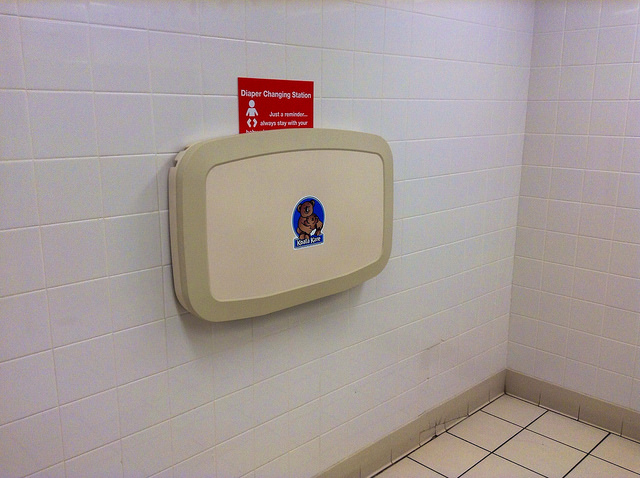
TORONTO — A Quebec dad’s fight to get a change table in his local Tim Hortons has reignited a campaign by some fathers to make the folding baby stations a standard feature in men’s bathrooms across the country.
Jeremy McCall of the London, Ont.-based parent group Dad Club London says he’s inspired by the story of Chris Webb, the Montreal-area father whose complaints about a local cafe were followed by a move from Tim Hortons to quickly install a change table for dads who visit the Pincourt, Que., location.
McCall says it’s a battle he and other parents have been waging against local businesses in southwestern Ontario for two years, when they set up an online petition urging eateries to add change tables if they had none in their men’s bathrooms.
“It’s reignited our spark,” McCall says of the Tim Hortons flap, vowing to target other large companies.
“I never thought that we would convince people on a national level that this is necessary so actually we reached out to Chris and we’re going to see if we can formulate a plan together to maybe approach other national chains that do attract families and see if we can make this a standard.”
It soon will be standard for Tim Hortons, a spokeswoman says.
Devinder Lamsar says the coffee giant is spending $700 million to redesign the interior and exterior of its Canadian outlets, and that includes ensuring change tables are accessible to both men and women. She says that could either mean change tables in both men’s and women’s bathrooms or a shared family room accessible by all.
She adds that the four-year plan was announced back in March and was not related to Webb’s complaint.
Webb says he’s happy change is underway at Tim Hortons, but says his complaint was “about bigger issues,” noting he’s also frustrated by a lack of change tables at some malls and community centres he’s visited.
He’d like to see changing facilities provided for men and women in every public washroom in the country.
“Tim Hortons was the tipping point for me,” says Webb, the father of a three-year-old girl and 14-month-old boy.
“This is a story across the board. It doesn’t matter where you’re going, what’s happening, it seems to be that the expectation is that moms look after the baby and that dads are kind of along for the ride. It seems very inconsistent as to where you can find the change table and where you can’t find a change table to use as a man.”
McCall, whose registered non-profit group has 1,700 members, says his group has approached about a dozen small businesses with similar complaints. The outlets have been quick to comply once they see his group’s petition, which includes 760 signatures.
“The biggest backlash we got was the cost. ‘How can you force this on a small business owner?’ The reality is the change table is $332 last time we checked. And we usually … can bring out 20, 30, 40 people for a recognition event and they can make the money back pretty quickly,” says the 34-year-old McCall, who has three kids younger than six.
Restaurants Canada says that while most large national chains offer “some accommodations” for parents, customers do occasionally have to ask for family-friendly facilities — whether it’s change tables, high chairs or a comfortable spot to breastfeed.
There are no municipal ordinances, or provincial or federal regulations that require change tables in restaurants, says vice president David Lefebvre, whose not-for-profit association represents more than 30,000 food service professionals. But he is loathe to suggest a blanket policy on such a wide-ranging industry.
“I’m not sure this is something that can really be legislated or regulated because it’s hard to have a solution that can apply everywhere,” Lefebvre says from Gatineau, Que.
“(But) I think there’s some market-driven solutions that are really efficient right now. Not to say that everything is perfect, but I think it’s moving in the right direction and you cannot expect everything to change in a few years.”
Cost and space are the two biggest barriers outlets may face, he says, noting that some restaurants are so small that a retrofit would be “prohibitive,” or make it “impossible to install a changing table.”
“It’s a little bit expensive because you figure you’re in an industry with an average pre-tax margin of 4.2 per cent,” he adds, nevertheless admitting that customer demand ultimately dictates what a business owner will do in order to stay afloat.
“Just by the sheer number of people that go to some restaurants, this is the real power — the power they get when they spend or choose to go elsewhere to spend.”
Webb says a lack of space is not a valid argument, and he urges the industry to get with the times.
“If you can put a change table in an airplane bathroom you can put one anywhere in the world, pretty much,” says the 34-year-old teacher. “Yes, it might be the world’s smallest change table, but you know what? I’d rather have a tiny surface that was a change table than nothing at all.”